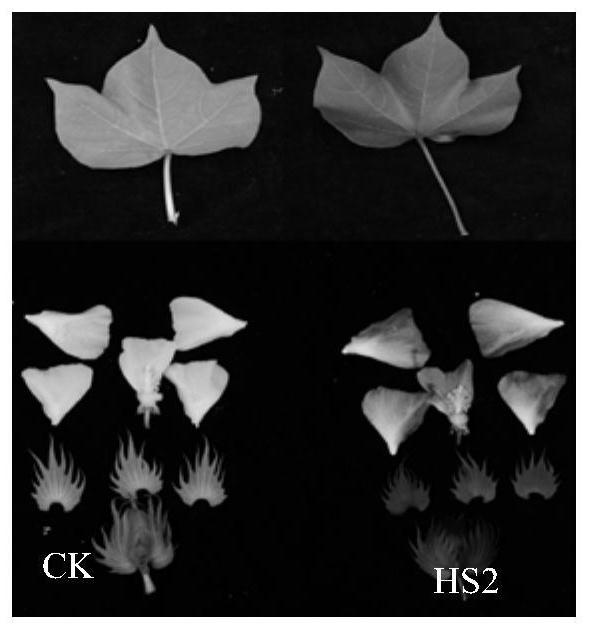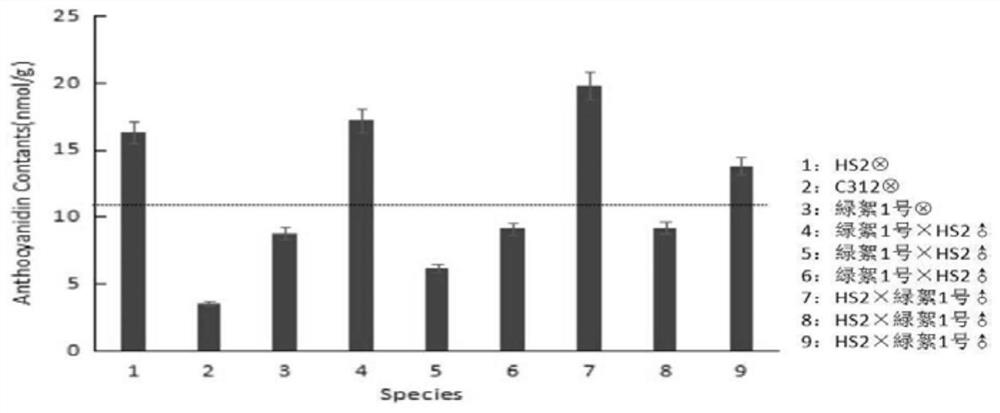A kind of cultivation method of colored cotton
A cultivation method and technology of colored cotton, applied in the direction of botany equipment and method, biochemical equipment and method, transferase, etc., can solve the problems of shortage, monotonous color of colored cotton, low color saturation, etc., and achieve strength and yield increase Effect
- Summary
- Abstract
- Description
- Claims
- Application Information
AI Technical Summary
Problems solved by technology
Method used
Image
Examples
Embodiment 1
[0059] Example 1 Using upland cotton violet mutant HS2 to cultivate new colored cotton
[0060] 1. Acquisition of cotton violet mutant HS2
[0061] The constructed T-DNA expression vector (pBI121) was transferred to the Agrobacterium LB4404 strain for expanded culture, and the cotton C312 seedling hypocotyl was used as the explant, respectively, and the Agrobacterium LB4404 loaded with the T-DNA vector was in the basal induction medium ( MSB5 medium, 2,4-D (2,4-dichlorophenoxyacetic acid) 0.1 mg / L + KT (cytokinin) 0.1 mg / L) were co-cultured at 23°C for 36-48 h. The hypocotyls after co-cultivation were washed with sterile water containing cephalosporin (500mg / L), and then the hypocotyls were incubated in induction medium (MSB5 medium, 2,4-D 0.1mg / L+KT 0.1mg / L). L+Kanamycin 50mg / L), cultured at 28°C to induce embryogenic callus. Transfer resistant embryogenic callus to screening medium (MSB5 medium, IBA (indole acetic acid) 0.5 mg / L + KT 0.15 mg / L + kanamycin 50 mg / L) to scree...
Embodiment 2
[0080] Example 2 Using RNAi to interfere with GhCHS, GhANR, and GhLAR genes respectively leads to changes in color fiber color
[0081] Clone full-length GhCHS, GhANR, and GhLAR genes, and select the genes GhCHS (nucleotide sequence shown in SEQ ID NO. 5), GhANR (nucleotide sequence shown in SEQ ID NO. 6), GhLAR (nucleoside sequence The acid sequence is shown in SEQ ID NO.7) specific sequence fragment to construct the interference expression vector of GhCHS, GhANR and GhLAR genes, through cotyledon osmotic injection method (method refer to Fu et al.Acyl-CoA N-acyltransferase influences fertility by regulatinglipid metabolism and jasmonic acid biogenesis in cotton. Scientific Reports, 2015, 5:11790) Electrotransformation of Agrobacterium GV3101.
[0082] The cDNA sequence of the target gene was found in NCBI, and the virus interference primers of GhPDS, GhCHS, GhANR, and GhLAR were designed by the software Primer Express 5.0. Amplification (Table 1).
[0083] Table 1 Target g...
Embodiment 3
[0094] Example 3 Using RNAi to interfere with GhOMT1 gene to cultivate red cotton
[0095] (1) The GhOMT1 gene (shown in SEQ ID NO. 1) was inserted into the plant expression vector pBI121-35S-NOS in the forward direction, and the CaMV35S promoter was used to promote the expression, and the plant expression vector pBI21-35S-GhOMT1- containing the GhOMT1 gene was constructed. NOS, such as Figure 14 .
[0096] The GhOMT1 gene fragment (shown in SEQ ID NO. 1) was inserted into the plant interference expression vector pB7GWIWG2(II), and the CaMV35S promoter was used to promote the expression, and the plant interference expression vector pB7GWIWG2(II)-GhOMT1-F- containing the GhOMT1 gene was constructed. T35S, such as Figure 15 .
[0097] The constructed vector was transformed into competent DH-5α E. coli by heat shock method, and the recombinant was cultured in LB kanamycin selective medium during this process. The plasmid pB7GWIWG2(II)-GhOMT1, extracted from Escherichia coli ...
PUM
| Property | Measurement | Unit |
|---|---|---|
| wavelength | aaaaa | aaaaa |
| degree of polymerization | aaaaa | aaaaa |
Abstract
Description
Claims
Application Information
 Login to View More
Login to View More - R&D
- Intellectual Property
- Life Sciences
- Materials
- Tech Scout
- Unparalleled Data Quality
- Higher Quality Content
- 60% Fewer Hallucinations
Browse by: Latest US Patents, China's latest patents, Technical Efficacy Thesaurus, Application Domain, Technology Topic, Popular Technical Reports.
© 2025 PatSnap. All rights reserved.Legal|Privacy policy|Modern Slavery Act Transparency Statement|Sitemap|About US| Contact US: help@patsnap.com



